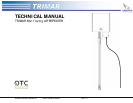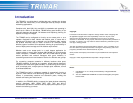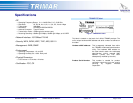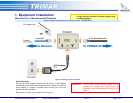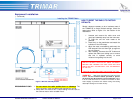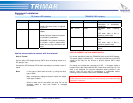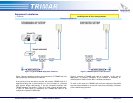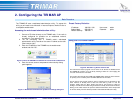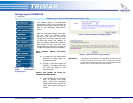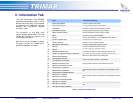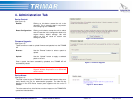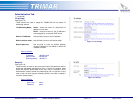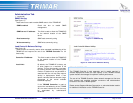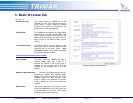
Features
GENERAL:
Enterprise-class wireless LAN capable of supporting up to 48
infrastructure stations/users.
Power-Over-Ethernet system (POE) allows individual radios to be
powered over the same cable used to carry data.
SSID:
Supports multiple SSIDs. Up to eight simultaneous virtual APs
can be supported by each TRIMAR radio.
Each SSID can have its own individual security and authentication
configuration that supports WEP, WPA or WPA2 (802.11i).
One of the custom configured SSIDs can be selected as the
visible SSID that will be broadcasted in the beacon. The station
users can scan and only see this visible SSID.
The visible SSID can be reserved for guest users. All of the other
SSIDs can be reserved for use by company employees.
TRIMARs can also be configured with none of their SSIDs being
visible.
WIRELESS:
Supports 802.11a and 802.11b/g. A TRIMAR radio can be used in
either 802.11a mode or 802.11b/g mode; but not in both modes
simultaneously.
Supports Atheros SuperA/G turbo mode to boost data rates up to
108Mbps.
Dynamic turbo mode.
Auto-channel setting to allow the radio to select the best channel
automatically during system boot-up.
All APs that are wirelessly linked together need to share the same
channel but can use different SSIDs.
WIRLESS MESH:
Supports WDS (Wireless Distribution System) with STP (Spanning
Tree Protocol) to link with other APs to form a large wireless
mesh network.
The WDS connection supports unsecured as well as WEP
encrypted deployments.
SECURITY:
WPA/WPA2 support for TKIP and AES cipher type with personal
(PSK) and enterprise authentication (through 802.1x with
RADIUS server).
Two RADIUS servers setup per each virtual AP to provide flexible
and redundant deployment.
Supports four WEP keys (64-bits/128-bits) and authentication
type (open / shared key) is shared by each virtual AP and WDS
services.
Individual local bridging enable/disable. When disabled, even
stations assigned with the same SSID cannot communicate with
each other.
WEP key is shared with other virtual APs in the same BSS
network.
NETWORK:
Supports VLAN (Virtual Local Area Network) tags on each virtual
AP. (This function requires a VLAN capable switch or router).
VLAN tagging can be enabled/disabled for each individual SSID.
Each virtual AP can be assigned a unique VLAN ID (1 to 4095).
The VLAN ID determines to which VLAN a station belongs when
the station associated with the SSID.
VLAN support provides more secure network deployment.
Traffic for each individual VLAN ID is separated from each other.
NETWORK MANAGEMENT:
SNMP v1 and v2 with OTC enterprise MIB for total wireless
management.
PEGASUS WIRELESS CORPORATION TRIMAR TECHNICAL MANUAL Version 1.0 Page 3 of 32



